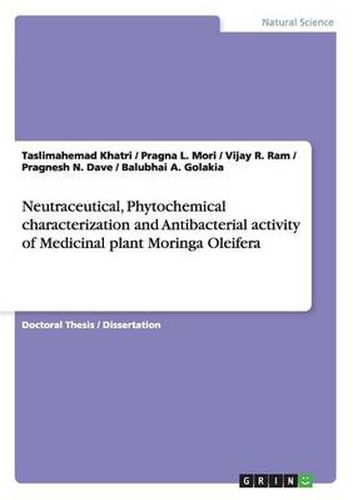Neutraceutical, Phytochemical characterization and Antibacterial activity of Medicinal plant Moringa Oleifera
Taslimahemad Khatri,Pragna L Mori,Vijay R Ram

Neutraceutical, Phytochemical characterization and Antibacterial activity of Medicinal plant Moringa Oleifera
Taslimahemad Khatri,Pragna L Mori,Vijay R Ram
Doctoral Thesis / Dissertation from the year 2012 in the subject Chemistry - Analytical Chemistry, grade: 3, Kachchh University (Department of Chemistry), course: MSc, language: English, abstract: Moringa oleifera, an important medicinal plant is one of the most widely cultivated species of the family Moringaceae. It is highly valued from time immemorial because of its vast medicinal properties. The present study provides all necessary information regarding of four parts such as flower, leaves, seed and pulp of moringa like biochemical, phytochemical, mineral, antibacterial activity and its nutritional value. The benefits of essential nutrients and minerals for maintaining good health were also highlighted in this study. The results of proximate analysis of Moringa oleifera revealed that the protein (9.37%), carbohydrate (7.33%), ascorbic acid (2.10%) and total soluble sugar (0.73%) were highest in flower as compared to leaves, seed and pulp. While free amino acid (9.84%) was found to be higher in seed, total phenol (0.29%) was higher in leaves and reducing sugar (0.43%) higher in pulp of the moringa. The result of qualitative analysis of amino acid represented that lysine, glycine, threonine, valine, Isoleucine, tryptophan, alanine and cystein were present in moringa. The flower also contained higher amounts of crude fibre (0.23%) as well as moisture (90.56%), while fat (15.53%) content was found higher in seed. The dry matter (30.40%) and total ash (2.12%) content were higher in leaves. The ash content represented minerals in different amounts. The higher amount of potassium was found in flower (50.9%), seed (40.7%) and pulp (77.00%). Leaves contained higher amount of Calcium (57.18%). However Aluminum (10.00%) and Magnesium (6.07%) were found only in leaves. The result of heavy metal (zinc, lead and cadmium) and analysis represented that flower, leaves, seed and pulp have zinc (Zn), lead (Pb) and cadmium (Cd) found in lower amount then permissible limit for hum
This item is not currently in-stock. It can be ordered online and is expected to ship in approx 2 weeks
Our stock data is updated periodically, and availability may change throughout the day for in-demand items. Please call the relevant shop for the most current stock information. Prices are subject to change without notice.
Sign in or become a Readings Member to add this title to a wishlist.


